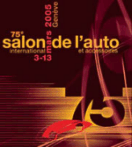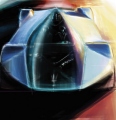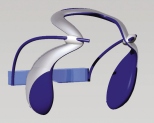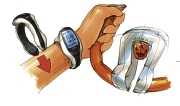

.





.
.





..
.
.
.
.
.
.

Other Pininfarina
workpieces



Other Engineering Companies & Coachbuilder
© 1998 - 2004
Copyright &
Disclaimer
Automotive Intelligence,
www.autointell.com
All Rights Reserved .
For questions please contact
editor@autointell.com
|
.
.

Pininfarina: Birdcase 75th Concept


With the Birdcage 75th, based on the Maserati heritage and on its most
advanced mechanicals and realized in collaboration with Motorola,
Pininfarina revives the storied theme of the true dream car now proposed in
a synthesis of the vision of the three companies: exclusive design, sports
DNA and technological innovation.
|

Click image for larger view

Click image for larger view
|
|
Pininfarina’s prosperous
collaboration with Maserati, marked by the great international success of
the Quattroporte, is celebrated with this rolling hi-tech sculpture that
evokes a new future context, imaginary but possible, while simultaneously
paying homage to the strong and distinctive brand characteristics of the
Tridente.
|

Click image for larger view

Click image for larger view

Click image for larger view

Click image for larger view

Click image for larger view
|
In celebration of
Pininfarina’s 75th anniversary, Birdcage 75th returns to the storied
tradition of extreme sports prototypes which highlighted the Italian
renaissance of car design, born in the Fifties and prolonged in the Sixties
and early Seventies. This period of optimism and boundless creativity
produced some of the world’s most astounding and beautiful automobiles.
Never before had our love affair with speed and beauty been so abundantly
expressed. Boldly challenging our aesthetic ideals, these prototypes were
exercises in creativity and passion, unconstrained by the regulations and
the limitations of today’s context and considerations. They were true dream
cars that evoked images and sentiments of a utopian future.
Beginning with the Maserati
A6 GCS of 1954, whose clean-lined design and harmonious proportions made it
one of the most memorable projects from that period, Pininfarina embarked on
a prolific period of extreme sports prototypes based on the era’s state of
the art racing car mechanicals. In 1965 the stunning Ferrari Dino Berlinetta
Speciale made its debut, while in 1967 the Dino competizione combined
voluptuous beauty with some of the world’s first studies on moveable aero
devices. The following year brought about the aero study of the Alfa Romeo
33 and the sensual Ferrari P5, which demonstrated a future vision of Le Mans
prototypes. 1969 bore three radically different prototypes, the Abarth 2000,
the sinuous Alfa Romeo 33 Prototipo Speciale and the extreme wedge study of
the 512s which stood less than 1 meter tall. Finally, in 1970 arrived what
many consider the preeminent dream car of the era, the audacious Ferrari
Modulo.
A radical
research vehicle which abandoned traditional styling and construction
techniques in favor of extreme geometric simplicity. Originally shown at
Geneva, Turin and the Osaka World Fair, the excited and shocked public was
forced to question its very context. How and where did this vehicle come
about? Where would this vehicle take us? Effectively, the Modulo represented
the ultimate manifestation of the dream car spirit, for it succeeded in
transporting its viewer to another time and place. |
For 2005,
in celebration of its 75th anniversary, Pininfarina has chosen to rekindle
this creative spirit. The Birdcage 75th is a concept of a road car where
everything – style, performance, use and conception of the car – is extreme
so as to get the maximum impact on the collective imagination. The car is a
futuristic extension of the Maserati brand, and at the same time it serves
to reinforce the Tridente’s potent design heritage, and continues its grand
tradition of advanced technology enveloped in sporting elegance. Integrating
some Motorola technologies make the Seamless Mobility vision real, or the
fluidity of the technologies as a subsequent stage of the Internet
revolution.
SEAMLESS MOBILITY BY MOTOROLA
|
The Birdcage 75th is an
application of Motorola’s vision of seamless mobility. Telephony has
revealed the existence of a world in constant movement, to the point
that it is difficult today to imagine life without the mobile phone.
Nowadays, when we travel, we are no longer content to just make a phone
call: we also want to be able to access all manner of services with our
phone. Motorola has made all this possible. And it doesn’t end there. We
want to be able to send images and listen to music: our wishes have been
fulfilled. Now Motorola is ready for the next step. People are
constantly on the move and they want to have everything with them. |

Telephone & Organizer in the headrest of the car |
They want a seamless mobility world. Solutions that make you live the
experience of always being connected, to everything and with all services
available. “Mobility” is the next stage in the Internet revolution; it
will enable users to communicate and handle information independently of
the place they happen to be.
|
 |
The technologies integrated in the concept car fulfil this vision of
seamless mobility and use payment systems, an iPen and a mobile router,
putting projection screens into service for man-machine communication.
 |
The idea of building a concept car with Motorola arose when the company in
the Pininfarina group dedicated to industrial design, Pininfarina Extra,
already a Motorola partner in the design of its last line of cell phones
with iDEN technology, began to plan the new line of terminals.
|
The new portfolio of
iDEN products combines attractively designed lines with the very latest
available technologies, digital cell phones with last generation
wireless access to Internet, text pager and two-way radio communication
which enables users to communicate instantaneously with one or more
individuals simply by pressing a button. |
 |
Technical Specification
|
Chassis:
load-bearing frame in carbon fibre and Nomex honeycomb with front and
rear structure in aluminium. Bodywork in carbon fibre.
Front and Rear Suspensions: articulated quadrilateral with
push-rod layout; single-calibrated shock absorbers and co-axial coil
springs.
Brakes: Brembo system with four self-ventilated and drilled
discs. Front 380 mm x 34 mm, Rear 335 mm x 32 mm; callipers in light
alloy with six front and four rear pistons.
Drivetrain: Longitudinal rear-mounted gearbox with rigid
connection to the engine. Mechanical drivetrain with 6 sequential gears.
Engine: 12 x 65° V-cylinders, displacement 5998 cm(3). Power
output: more than 700HP. |
Photos: Pininfarina/ AutoIntell
|



















